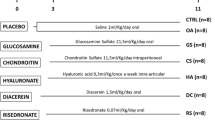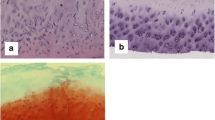Summary
The present paper presents data obtained over a 12 year period, on the matrix synthesis and turnover in some 650 arthritic and 180 non-arthritic (N) human cartilages using a standardised in vitro method. When the relative metabolic (synthetic/repair activity) of these human cartilages was compared, it was demonstrated that in osteoarthritis (OA) and rheumatoid arthritis (RA) cartilages synthetic activity was diminished by approximately 50% as compared with N cartilages. However, the turnover rate of matrix was not significantly different between Non-arthritic and OA, but was very substantially increased in RA cartilages compatible with the activity of inflammatory cells and proteolytic enzymes released from pannus. The action of 13 NSAIDs was compared in terms of their effect on cartilage GAG synthesis. 3 of these NSAIDs were also studied in terms of their effect on cartilage collagen synthesis. Consideration of the results in this study and from published material, led to the suggestion that NSAIDs may be divided into 3 categories in respect of their in vitro action on the extracellular matrix of human arthritic cartilages: 1. Those such as Aceclofenac, Tenidap and Tolmetin which can stimulate matrix synthesis 2. Those such as Piroxicam, Tiaprofenic Acid and Aspirin which appear to be without significant effect on matrix synthesis and, 3. Those like Naproxen, Ibuprofen, Indomethacin, Nimezulide which significantly inhibit matrix synthesis. It is suggested that the stimulatory action of group 1 NSAID is due to inhibition of locally produced IL1 and consequent expression of growth factor activity. Other NSAIDs may also inhibit IL1 synthesis or release, but probably do not have a beneficial effect on chondrocyte synthetic activity as they have toxic effects on cartilage metabolism. These experiments led to the suggestion that NSAIDs such as Aceclofenac would be appropriate for long-term treatment of arthritic conditions provided that one is prepared to extrapolate between in vitro experiments on human cartilage and what may be happening in vivo.
Zusammenfassung
Die vorliegende Arbeit präsentiert während einer 12-Jahres-Periode mit einer Standard-in-vitro-Methode gesammelte Daten über Synthese und Umsatz des Gelenkknorpels von 650 arthritischen und 180 nicht-arthritischen (N) Individuen. Beim Vergleich der relativen metabolischen (synthetischen/reparativen Aktivität) dieser menschlichen Gelenkknorpel läßt sich zeigen, daß bei der Arthrose (OA) und der rheumatoiden Arthritis (RA) die Knorpelsynthese um etwa 50% im Vergleich zu N-Knorpeln reduziert ist. Bezüglich des Matrixumsatzes aber gab es keinen signifikanten Unterschied zwischen nicht-arthritischem und arthrotischem Knorpel, während dieser beim RA-Knorpel – vereinbar mit der Aktivität von Entzündungszellen und aus dem Pannus freigesetzten Enzymen – deutlich erhöht war. Die Wirkung von 13 NSAR auf die Glukoseaminoglykansynthese wurde verglichen. Drei dieser NSAR wurden auch auf ihre Wirkung auf die Knorpel-Kollagen-Synthese untersucht. Die Ergebnisse dieser Studie und Literaturangaben führen zu dem Vorschlag die NSAR bezüglich ihrer in-vitro-Wirkung auf die extrazelluläre Matrix des arthritischen Gelenkknorpels in drei Kategorien zu teilen:
1. Substanzen wie Aceclofenac, Tenidap und Tolmetin, die die Matrixsynthese stimulieren können 2. Substanzen wir Piroxicam, Tiaprofensäure und Aspirin ohne signifikanten Effekt auf die Matrixsynthese und 3. Substanzen wie Naproxen, Ibuprofen, Indometacin, Nimezulide, die die Matrixsynthese signifikant hemmen.
Es ist anzunehmen, daß die stimulierende Wirkung der NSAR der Gruppe 1 auf die Hemmung des lokal produzierten IL-1 und die nachfolgend zunehmende Aktivität von Wachstumsfaktoren zurückzuführen ist. Andere NSAR können Synthese oder Freisetzung von IL-1 ebenfalls hemmen, hemmen möglicherweise aber gleichzeitig aufgrund toxischer Effekte die synthetische Aktivität der Chondrozyten. Diese Experimente weisen darauf hin, daß NSAR wie Aceclofenac für die Langzeitbehandlung der Arthritis geeignet sind, vorausgesetzt, die in-vitro Experimente am menschlichen Knorpel lassen sich auf die Situation in-vivo übertragen.
Similar content being viewed by others
Author information
Authors and Affiliations
Rights and permissions
About this article
Cite this article
Dingle, J. The effects of NSAID on the matrix of human articular cartilages. Z Rheumatol 58, 125–129 (1999). https://doi.org/10.1007/s003930050161
Issue Date:
DOI: https://doi.org/10.1007/s003930050161




